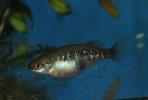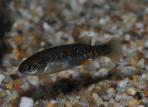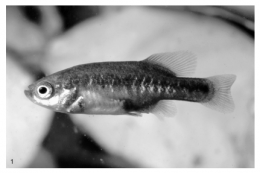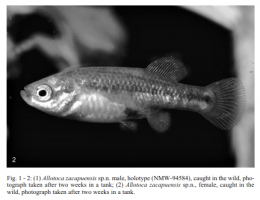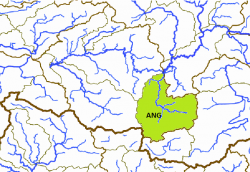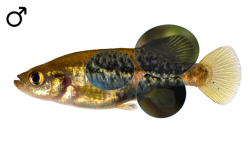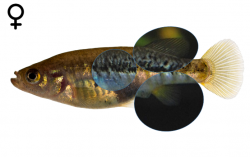- HOME
- WHO WE ARE
- NEWS AND DATES
- GOODEIDS
- PHYLOGENY
- ARTIFICIAL KEY
- GOODEID SPECIES
- BIOLOGY
- ENVIRONMENT
- CONSERVATION
- PROFUNDULIDS
- MEMBERS AREA
Allotoca zacapuensis
English Name:
Zacapú Allotoca
Mexican Name:
Tiro de Lago de Zacapú
Original Description:
MEYER, M. K., RADDA, A. C. & O. DOMINGUEZ-DOMINGUEZ (2001): Notes on the genera Neoophorus HUBBS & TURNER, 1937 and Allotoca HUBBS & TURNER, 1937, with a description of a new species of Allotoca from Laguna de Zacapu, Michoacán, Mexico (Teleostei, Cyprinodontiformes: Goodeidae). Annalen des Naturhistorischen Museums in Wien (103B): pp 453-460
Holotype:
Collection-number: Naturhistorisches Museum Wien, Cat. No. NMW-94584.
The Holotype is a young male of 22.1mm standard length, collected by M. K. Meyer, A. C. Radda and C. E. Rivas Benitez on February the 14th, 2001. The female Allotype (Cat. No. NMW-94585) was collected two days later by A. C. Radda and S. Mendoza Caideron. Another six specimens (SMF-28887) used for the described were collected on July the 14th, 1990, by Derek Lambert and another nine (CPUM-1079) by Omar Domínguez Domínguez and E. Gonzales on March the 19th, 1998.
The Holotype (left) and a female (right) of Allotoca zacapuensis:
Terra typica:
The Holotype was collected in the Lago (or Laguna) de Zacapú in the federal state of Michoacán.
Etymology:
The species is named for the Lago de Zacapú, the type location of this species, and its only known location at the time of the description. The word zacapú again, in use for the town and the lake, is from Nahuatl origin, the language of the Aztec people, with "zacapú" meaning place of stones.
The genus Allotoca was erected by Hubbs and Turner, published by Turner in 1937 and taken from the manuscript of the famous monography about Goodeids that Hubbs & Turner finally published together in 1939. Though the authors mentioned the posterior insertion of the dorsal fin, "the more fundamental characters of Allotoca, however, are ovarian and trophotenial..." The word ἄλλος (állos) means different and τόκος (tókos) offspring, so the genus refers to the different looking trophotaenia of the fry with the generic name meaning "different offspring".
Synonyms:
none
Distribution and ESU's:
The Zacapú Allotoca is endemic to the Mexican federal state of Michoacán and inhabits the flat area of the former Zacapú paleolake. Until recently known only from spring areas within the Lago Zacapú, it was in 2013 additonally discovered in a tiny spring in the village of Jesús Mária, becoming an affluent of the Canal Patera, the main source of the Río Angulo at Villa Jiménez. This spring is about 35km ENE of Zacapú. In the lake, it is known from only two spring areas where it is rare but apparently relatively stable in numbers (Domínguez-Domínguez et al., 2005). No subpopulations are distinguished. The bold names are the ones officially used by the Instituto Nacional de Estadística y Geografía; nevertheless, other ones might be more often in use or better known and therefore prefered.
ESU ist short for Evolutionarily Significant Unit. Each unit expresses an isolated population with different genetic characteristics within one species. ESU's can be defined by Molecular genetics, Morphology and/or Zoogeography and help in indicating different phylogenetic lineages within a species. The abbreviation for an ESU is composed of three letters of the genus, followed by the first two letters of the species name and an ongoing number in each species.
All fish from this species belong to one ESU, so in Allotoca zacapuensis there is only Altza1.
The left map shows the Río Lerma-Chapala basin from the Hydrographic Region Lerma-Santiago on a Mexico map. Within the Lower Río Lerma-Chapala basin, the Zacapú Allotoca occurs exclusively in the Río Angulo subbasin (ANG), shown on the right map:
Status :
International Union for Conservation of Nature (IUCN): Critically Endangered
Distribution and current conservation status of the Mexican Goodeidae (Lyons et al., 2019): Critically Endangered/stable: „This species was described in 2001 (Meyer et al., 2001) and is known only from Lake Zacapu and a tributary spring, Jesus Maria, which are in the headwaters of the Angulo River drainage in the Lerma River basin. Within the lake it is known from only two spring-fed areas where it is uncommon but apparently relatively stable in numbers (Domínguez-Domínguez et al., 2005).“
NOM-059-SEMARNAT-2010: no categoría de riesgo (no category of risk)
Habitat:
The Lago Zacapú is an irregular shaped small spring fed lake with an extension from the NW to the SW, length about 670, width about 470m. In the SE corner of the lake begins the dammed outlet, extending ENE upward over a length of about 800m and 60m wide over the whole length. The outlet ends with a southwards bended hook with an extension of 150x90m. After the dam, the affluent of the Canal or Río Angulo begins and merges into it after about 6.5km. The habitat at the collection point of the describers was 0.5 to 1m deep and the ground predominantly of mud which led to a translucent (greenish) to turbid water. The Zacapú Allotoca prefers well planted areas, where it is hiding beneath the aquatic vegetation, including Chara, Potamogeton, Ceratophyllum and green algae. On a survey of the GWG (2014), the species was found in shallow water between dense roots and foliage of willow trees (Salix sp.). The water was greenish brown but clear, little current and partly shaded by trees. Other species found at this spot were Skiffia lermae, Xenotoca variata, Goodea atripinnis, Hubbsina turneri and Zoogoneticus quitzeoensis. Kees de Jong (2013) described the habitat in Jesus María as some springs formed with concrete into rectangular basins. These basins were populated with swordtails (Xiphophorus hellerii). The water flew out in some shallow creeks trough a marshy area, more or less a densely planted swamp or flooded sodden grass. The Highland Splitfin was found together with Hubbsina turneri only in the creek outside of the little forest with the springs, both in small numbers.
Biology:
The knowledge about the ecology and behavior of this species in the wild is limited. However, Moncayo-Estrada (1996) addressed relevant aspects of its ecology, while Ramírez-García et al. (2021) provided key information on its life history. Between May 2019 and March 2020, these authors reported a sex ratio of two females to one male. Both studies reported an extremely small population size, which is evidence of the high vulnerability of the species. Observations in captivity suggest, that the Zacapú Allotoca might be difficult in keeping at temperatures higher than 22°C on the long term.
Diet:
The teeth and gut length are typical for Allotoca and suggest a carnivorous feeding habit.
Size:
The maximum known standard length is 50mm (Miller et al., 2005).
Colouration:
The ground colour of the body is greyish brown in both sexes. Blue, pink and green colour reflections appear along the midline and venter. The body side shows one series of 10 to 14 vertical bars, which are broad and most prominent on the rear body half. The longitudinal region has got sometimes dark blotches, most abundant in the middle. The scales of the upper body sides present a dark coloured reticulum. The abdominal region posseses a dark brown coloured area. The dorsal fin is light orange, anal fin and caudal fin are light yellow or orange, the paired fins are hyaline.
Sexual Dimorphism:
At first appearance, males and females of the Zacapú Allotoca are not very easy to distinguish. The safest characteristic is the Splitfin in males, means the for Goodeinae typical mating organ formed by a notch after the first seven shortened rays of the Anal fin. Additionally, male Allotoca zacapuensis have a bigger Dorsal fin than females. A difference in colouration is usually visible like a yellow base of the Anal fin in females and yellow to orange stripes on the caudal peduncle. Additionally, males are usually darker mottled than females and the colour of the body is superimposed by a golden shine, but these colour differences dislimn when the fish get older. Older females are golden as well with many blotches and spots. Females are a bit longer than males with a slightly bigger and blunt head, but some experience is necessary to see this character.
Remarks:
The Zacapú lake had once been a large cienega (33 500ha), but was drained to provide land for cultivation. It is now a small waterbody with only 33.5ha in size. It posseses a rich aquatic vegetation (more than a dozen abundant plants and some more species), and the distribution pattern of these plants has importance for the Zacapú fish fauna, which includes besides this Allotoca six more Goodeid species and a few others, including some exotics like the common carp. As the Zacapú Allotoca is known from only two sites and is absent from about 95% (!) of the total Lake Zacapu area, it is regarded Critically Endangered. As a reaction on the threats this species is facing, the Austrian Association of Aquarists (ÖVVÖ) started a Studbook on this and all other Allotoca species (including the closely related Neoophorus regalis).
Allotoca zacapuensis was the last Allotoca species to be described until now. Miller (1987) reported in his description of Allotoca goslinei some forms "probably referable to Allotoca" from the Lago de Chapala and the riós Balsas and Armería basins. He labeled these forms as problematic to describe or identify because of poor material.
Husbandry:
Looking on the biotopes of Allotoca zacapuensis, they suggest the species may prefer a habitat with moderate current, structured with gravel, rocks, roots, branches, fallen leaves and river bank vegetation. Fry is eaten in some cases, but it may depend on the quantity and quality of food and on the number of places to hide. When several different stages of juveniles occur, fry may be neglected, so it makes sense to add separate brought up fry to the group with a size of 1.5 or 2cm to provide these stages and get a flock breeding colony.
The recommended tank size is at least 100 liters, bigger tanks with a generous base and little height (25cm are enough) are better for sure. With rocks and vegetation in the corners and backsinde of the tank well structured tanks combined with some roots and/or wood seem to do best with this species. The current should be moderate or swift, especially as the species is adapted to a high oxygene level (at least 8mg/l).
In the wild, the species feeds mainly from small or middle-sized invertebrates like bloodworms or insect larvae, so feeding with similar food, water fleas, Mysids and other food from animalistic sources will be best for this predatory fish. In aquarium, it feeds also well from flake food, granulate and even tablets, additionally given Nauplia of Brine Shrimps are eaten greedy. The species is acting a bit shy.
Concerning water quality, this species is in need of bigger water changes (60-80% every week) like most of the Goodeids, especially river and spring inhabiting species, so an automatic water changing system can be helpful. Otherwise, in combination with constant temperatures higher than 24°C, fish may get sick, lose resistance against diseases and age too fast. So for keeping the strain healthy and strong, give the fish a rest during winter time with temperatures lower than 20°C for 2 or 3 months so they stop producing fry. Allotoca species can be kept down to temperatures of 15-16°C without problems for months, some species even lower. In spring, when the temperature slowly increases, they will start spawning at 20 or 21°C and won't stop until it gets colder again or when it gets too warm (25°C).
This species is doing very well when is kept in the open from spring to fall, starting when the water temperature by day exceeds 15°C and cold periods are no longer expected. Bring them out in the early afternoon, the time of the day with the highest water temperature. During the warm summer, reproduction will stop and may occur again in fall. Bring the fish in before the water temperature deceeds 15°C by day and keep them cool for the first days, then slowly raise the temperature but try to stay below 20°C over the winter time.
Populations in holding:
Here each species are assigned populations of fish in husbandry and in brackets aliases of these locations to assist in identifying own stocks. Each population is assigned a unique Population-ID, composed by the ESU, the subbasin where this population is occurring (three capital letters) and a unique location identifier.
Populations in holding:
1. Altza1-ANG-LZac
Population: Laguna Zacapú (aka Lago de Zacapu, Zacapu)
Hydrographic region: Lerma-Santiago
Basin: Río Lerma-Chapala
Subbasin: Río Angulo
Locality: Laguna de Zacapú















